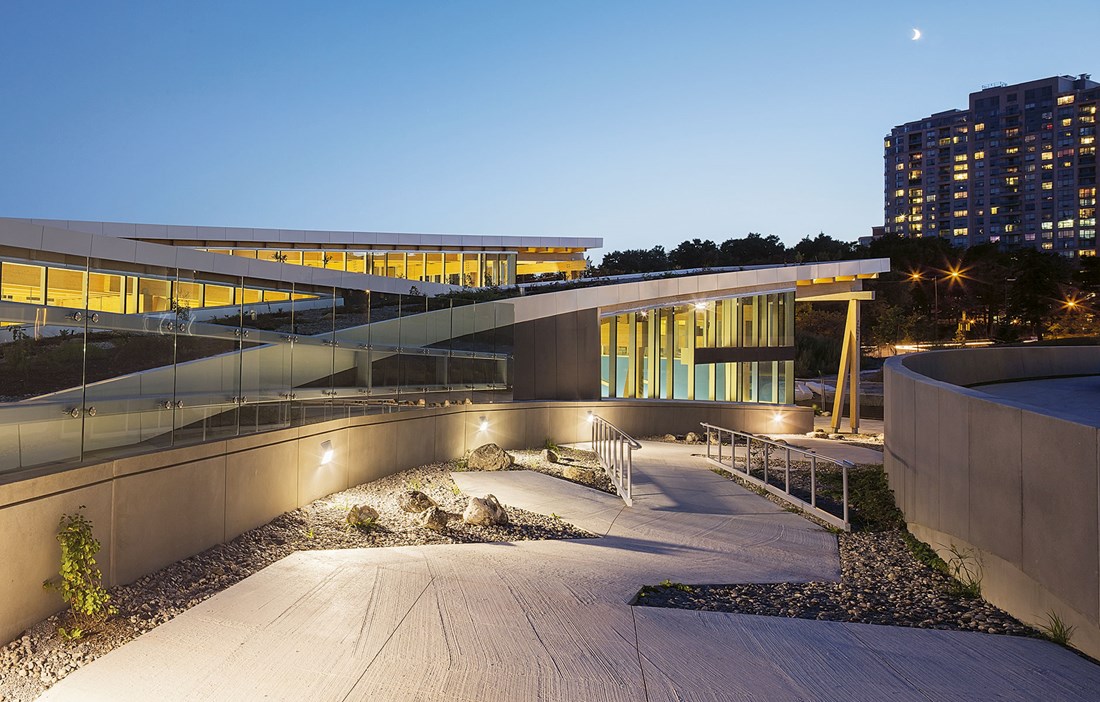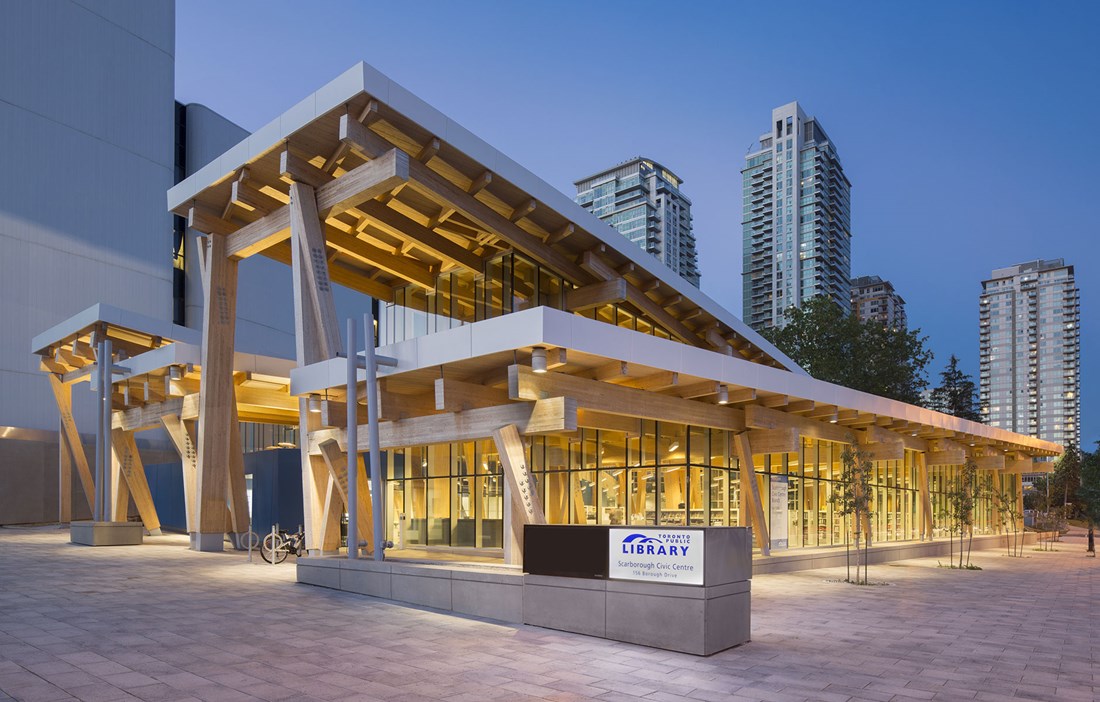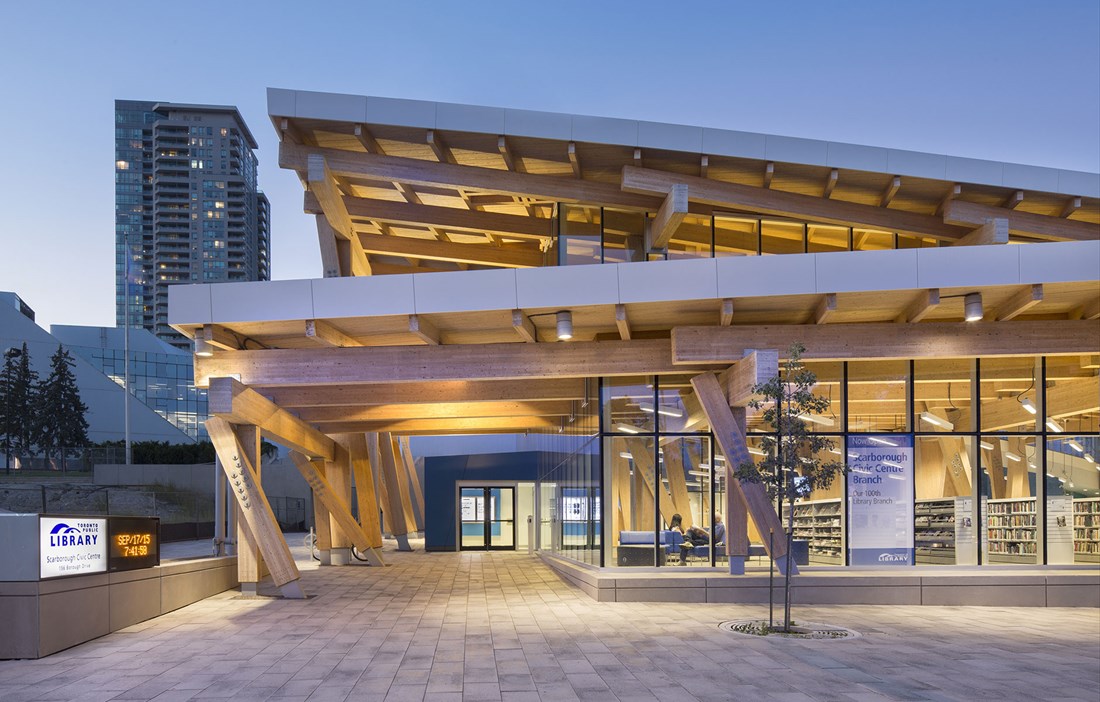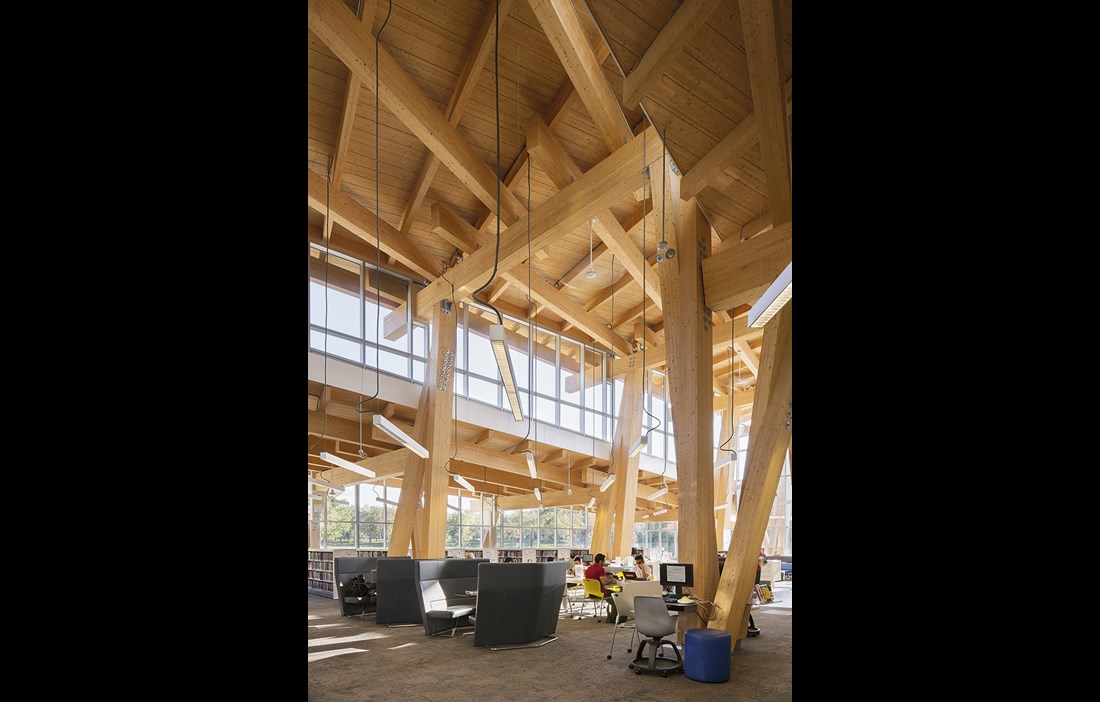SAND AND SALT-TOLERANT sitka spruces grow tall and bushy along Canada’s windswept Pacific coast. Inland, the spruces can be even bigger, in fact up to 100 metres. The compact conifer belt continues all the way to the Great Lakes and Niagara Falls in south-eastern Canada. Spruce, pine and poplar are the dominant tree species in a country that is home to 10 percent of the world’s forests.
Canadian architectural practice LGA has always liked working with wood. Ever since they set up shop in 1989, they have aimed to take the country’s forest resources and make as much use of them as possible in their projects. The newly built library in Scarborough, a suburb just outside central Toronto, is no exception. The building, which is a branch of the Toronto Public library, exclusively uses local black spruce in the glulam structure. The sustainability of wood is perhaps the most important aspect for LGA, but they are clear that the material has so many more benefits than that.
“We’ve designed many buildings that were not driven by profit, such as kindergartens or affordable housing, and they tend to have a limited budget. In that work, we’ve learned that wood can form a strong structure with such a wonderful finish that it doesn’t need to be hidden away in the finished building,” explains Brock James, lead architect on the library project.
THE STRUCTURE IS A PLAYFUL EXPLORATION of the relationship between pillars and beams. This is particularly prominent in the ceiling, with its three layers of beams. But the pillars also have an exciting design. They stand in pairs, with one of the pillars vertical and the other gently angled, crossing the vertical pillar to fix it in place. This solution is a direct result of the large expanses of glass that run along all the walls of the library. The extensive glazing, together with the large, open spaces inside the library, meant that there were few points that could handle horizontal loads.
“The pillars became incredibly important. The fact that they turned out to be so beautiful is a bonus, since the design was born out of pure necessity. Another issue we were forced to think about was the interface between the wooden structure and the glass. Because wood moves more than other materials over its lifetime, we had to build sufficient tolerances into the fittings.”
Through the windows in the roof, the library is able to benefit from natural daylight. To achieve this, the building was designed in four volumes with different roof heights, which created horizontal spaces between the roofs where windows could be placed. The windows in the walls and roof were important in connecting the library to its surroundings. The architects wanted the building to be an open place that influences its surroundings, while also taking cues and influences from them. This is true not least in the shape of the building and the material choices. The main entrance is at street level, which means that the building hunkers down into the slope on which it stands. There is also a small wooded area bordering the site. Having considered the location, the architects felt that a low building in wood, something that merged into the landscape, was the right way to go.
AN EVEN GREATER INFLUENCE on the design of the library was the classic Scarborough Civic Centre which stands right next-door. The building, by renowned Canadian architect Raymond Moriyama, was built in 1973 and is something of a Toronto landmark. The library was to be placed in front of the old building, partially breaking up the iconic silhouette. Showing respect for the centre was therefore important. But it was equally important for the library to have its own identity.
“We didn’t want to repeat Scarborough Civic Centre’s design. Instead, we designed a building that both contrasts with and complements the old building. While the centre is a light building with gentle vertical lines, the library is made up of horizontal lines, shadows and structure.
The building only took six weeks to erect once the prefabricated units had been delivered to the construction site. The short construction time, and the fact that the units were delivered with a protective cover, meant that the structural frame remained unaffected by snow and bad weather during erection. The actual construction phase went smoothly, but the practice learned lessons from the process as a whole.
“Next time, we want to find a way for the company manufacturing the structure to be involved at an earlier stage. The company we worked with had its own approach and standards for certain products that weren’t entirely compatible with our design, which meant we had to rework certain details. Everything therefore took a little longer.”
Having been a city largely built around the car, Toronto is now aiming for a more pedestrian friendly urban landscape. There are plans for more such accessible modern architecture and more places where people can come together. The library is a key part of this initiative. In addition to over 42,000 books, visitors also have access to advanced video editing facilities, recording studios and 3D printers. The tables and bookshelves are on wheels, so the library can change its layout and be adapted for different events. Under the floor, the personnel can reconfigure power and data sockets to further adapt the space.
“When designing a building with all this flexibility, you have to work on the architecture so that it can accommodate whatever changes the users make. One way is to have features that are strong enough that they won’t lose their identity. In the library, the ceiling plays that role.”
THANKS TO ITS HUGE EXPANSES of forest, Canada has a long tradition of working with wood. But it is not always seen as a modern material. In fact it is still seen as rather rural, or primarily for domestic environments. But things are starting to change, in terms of both attitudes towards the material and the regulations concerning large-scale wooden buildings. Only recently, permission was given to build up to six-storey high wooden structures in several states – and the potential to build even higher is under consideration.
Brock James is involved in the Canadian industry association Wood Works, which is tasked with promoting wood in new construction projects. In this arena, he has an opportunity to inform and lobby the public, architects and politicians about the advantages of wood. Reactions to the library in Toronto have been extremely positive, and one comment he read about the building in the newspapers really stayed with him.
“Someone wrote that the new library is exceedingly modern, but at the same time warm and welcoming. I think that’s great. I don’t see wood as a throwback to a rural building tradition. On the contrary, I think it’s a sophisticated material. Using wood in public buildings makes them feel welcoming, while at the same time they exude a sophisticated level of organisation. Just like all public buildings should.”
Text Erik Bredhe


























